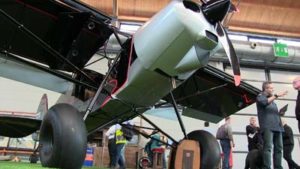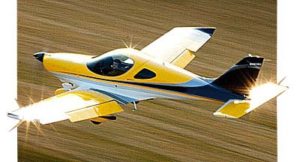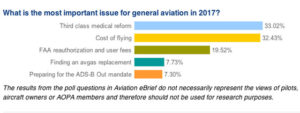Update 12/6/16 — According to AOPA Online, “The Federal Aviation Administration has reviewed the AOPA Air Safety Institute’s aeromedical online course and confirmed that it meets the third class medical reform requirements that Congress created last summer. Pilots would need to complete the course, which AOPA will offer for free, every two years in addition to seeing their personal physician every four years to operate under the law.
These steps are NOT required for anyone flying a LSA or Sport Pilot-eligible kit aircraft.—DJ
What issues are “most important” to general aviation pilots for 2017? Are “general aviation” pilots different than those of you who read ByDanJohnson.com? The second question can only be answered by each of you, independently.
My guess is that while you might consider yourself a GA pilot, you might also — or distinctively — consider yourself a “recreational” or “sport” pilot. Whatever label you prefer, I found the following chart of interest. The question was posed in an earlier edition of Aviation eBrief and after some compilation they released the results. I don’t know the current count of eBrief readers but it was once something like 65,000. Neither do I know, nor do they state, how many responses were used to compile these stats. My guess is that it was a large enough sample to be valid.

Here’s the Shock Cub (Outback Shock in America) offered by SportairUSA . Its price is far below the well-selling CarbonCub and a fraction of any new GA model.
AOPA reported, “Medical reforms have been passed by the House and Senate, and signed into law.” This action occurred on July 15th, 2016, even before last summer’s Oshkosh. The survey was done since that time.
So, still the biggest single issue is “Third class medical reform?” Hmm, seems odd to me but I found it on the Internet so it must be true.
The number two issue — hot on the heels of the number one issue — was the “Cost of flying.” It was not defined what cost this meant. Perhaps it was the overall cost. Or cost of operation. Or both. Likely, this was somewhat in the eye of the beholder.
Conclude what you will but I found it fascinating that the medical and the cost of flying comprised two-thirds of the pilots responding. The values sum to 100% so you were permitted one answer.

The sleek and highly refined BRM Aero Bristell is a handsome, superb-flying choice, a model in perhaps its fifth generation of evolution.
Sure, I know some LSA are priced beyond what many pilots can afford. Yet lower cost options abound, with prices well below $100,000 and a few selections closer to $50,000 and even that is for fully-built, ready-to-fly aircraft. What about kits, some of which can get airborne for $30,000. If you accept alternatives like trikes, powered parachutes, or gyros, the “cost of flying” can be held quite low. At even lower cost are ultralights, some below $20,000, less than the average price of a new car.
I have to wonder what these two-thirds of respondents are saying. Keep your aircraft choice under 1,320 pounds and you address both top issues. Do you get it? I don’t.
If you don’t receive Aviation eBrief and if you want it, you can sign up here. It is free. All of it may be of interest but it tends to focus on general aviation (i.e., certified aircraft) and only occasionally delves into recreational aviation or Light-Sport Aircraft.



Leave a Reply